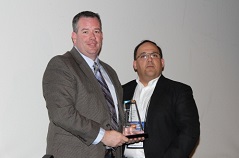Consumer Information on Lead and Copper
The Schuylkill County Municipal Authority would like to provide its customers with information on lead in drinking water. If present, elevated levels of lead can cause serious health problems, especially for pregnant women and young children. Lead in drinking water is primarily from materials and components associated with service lines and home plumbing.
The Schuylkill County Municipal Authority is responsible for providing high quality drinking water, but cannot control the variety of materials used in plumbing components. When your water has been sitting for several hours, you can minimize the potential for lead exposure by flushing your tap for 30 seconds to 2 minutes before using water for drinking or cooking.
How does Lead Get into Drinking Water?
Lead can enter drinking water when service pipes that contain lead corrode, especially where the water has high acidity or low mineral content that corrodes pipes and fixtures. The most common problem is with brass or chrome-plated brass faucets and fixtures with lead solder, from which significant amounts of lead can enter into the water, especially hot water.
Homes built before 1986 are more likely to have lead pipes, fixtures and solder. The Safe Drinking Water Act (SDWA) has reduced the maximum allowable lead content — that is, content that is considered “lead-free” — to be a weighted average of 0.25 percent calculated across the wetted surfaces of pipes, pipe fittings, plumbing fittings, and fixtures and 0.2 percent for solder and flux.
What are the Health Effects of Lead and Copper?*
Even though they are both regulated under the same regulatory framework of the Lead and Copper Rule, lead and copper differ greatly both in the types of adverse health effects that may arise following drinking water exposure and the concentrations at which these effects could occur.
Lead can cause serious health problems if too much enters your body from drinking water or other sources. It can cause damage to the brain and kidneys, and can interfere with the production of red blood cells that carry oxygen to all parts of your body. The greatest risk of lead exposure is to infants, young children, and pregnant women. Exposure to lead is a significant health concern, especially for young children and infants whose growing bodies tend to absorb more lead than the average adult. Scientists have linked the effects of lead on the brain with lowered IQ in children. Adults with kidney problems and high blood pressure can be affected by low levels of lead more than healthy adults. Lead is stored in the bones, and it can be released later in life. During pregnancy, the child receives lead from the mother’s bones, which may affect brain development. If you are concerned about lead exposures, you should ask your health care provider about testing your child for high levels of lead in the blood.
Copper is an essential nutrient, necessary, like some other metals, in the daily human diet to maintain good health because of the vital life-support functions that it provides. Without adequate copper intake humans get sick. Copper is essential to the healthy development and regulation of red blood cells, iron, cholesterol, glucose, immune systems, and the destruction of damaging free-radicals. A small amount of dietary copper should be ingested every day for good human health. The need for dietary copper has been acknowledged by health authorities around the world. The evidence suggests that dietary copper deficiency is a worldwide problem, while the incidence of adverse effects due to excess copper is relatively infrequent. Some people who drink water containing copper in excess of the action level over a relatively short amount of time could experience gastrointestinal distress. Some people who drink water containing copper in excess of the action level over many years could suffer liver or kidney damage. People with Wilson’s Disease should consult their doctor.
*The health effects information is not intended to catalog all possible health effects for lead and copper. Rather, it is intended to let you know about the most significant and probable health effects associated with lead and copper in drinking water.*
What are the Sources of Lead?
Lead is a common metal found in the environment. The main sources of lead exposure are lead-based paint and lead-contaminated dust or soil, and some plumbing materials. In addition, lead can be found in certain types of pottery, pewter, brass fixtures, food and cosmetics. Other sources include exposure in the work place and exposure from certain hobbies (lead can be carried on clothing or shoes). Brass faucets, fittings and valves, including those advertised as “lead-free”, may contribute lead to drinking water.
What Can I do to Reduce Exposure to Lead and Copper in Drinking Water?
- Run your water to flush out lead and copper. If water hasn’t been used for several hours, run water for 15-30 seconds or until it becomes cold or reaches a steady temperature before using it for drinking or cooking. This flushes lead-containing water from the pipes.
- Use cold water for cooking and preparing baby formula.
- Do not boil water to remove lead or copper.
- Identify and replace plumbing fixtures containing lead. Brass faucets, fittings and valves, including those advertised as “lead-free”, may contribute lead to drinking water. The Reduction of Lead in Drinking Water Act went into effect in January 4, 2014. The Act has reduced the lead content allowed in water system and plumbing products by changing the definition of lead free in Section 1417 of the Safe Drinking Water Act from not more than 8% lead content, to not more than a weighted average of 0.25% lead with respect to the wetted surfaces of pipes, pipe fittings, plumbing fittings, and plumbing fixtures. The Safe Drinking Water Act prohibits the use of these products in the installation or repair of any public water system or facility providing water for human consumption if they do not meet the lead free requirement. It also makes I unlawful to introduce them into commerce. This includes stocked inventories and coated or uncoated brass or bronze products. Visit the NSF Website at nsf.org to learn more about lead-containing plumbing fixtures.
- Find out if lead in drinking water is an issue in your child’s school or child care facility. Children spend a significant part of their days at school or in a child care facility. The faucets that provide water used for consumption, including drinking, cooking lunch, and preparing juice and infant formula, should be tested.
To find additional information on reducing lead exposure around your home and the health effects of lead, visit EPA’s website at: www.epa.gov/lead, call the National Lead Information Center at 800-424-LEAD, or contact your health care provider.
The Schuylkill County Municipal Authority regularly tests for lead and copper in our drinking water and has implemented corrosion control throughout the distribution system to minimize levels. We are required to collect and analyze 30 samples from the Pottsville system and 10 samples each from the Tremont, Pinebrook and SCMA Orwigsburg Interconnect systems. The 2016 sampling has recently been completed and the sample points and results can be seen below for each of our water systems.


























